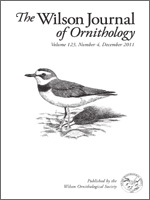We examined the effects of habitat change on Cerulean Warbler (Dendroica cerulea) populations at stops along Breeding Bird Survey (BBS) routes in the central Appalachians. We used aerial photographs to compare early (1967/1971), middle (1982/1985), and late (2000/2003) periods and compared 1992 and 2001 National Land Cover Data (NLCD). Mean Cerulean Warbler detections per stop decreased at 68 BBS stops between the early (0.05) and middle (0.01) time periods and their distribution became more restricted (15 vs. 3% of stops), but the amount of deciduous/mixed forest increased. Mean detections at 240 stops decreased from the middle (0.09) to the late (0.06) time periods, but the deciduous/mixed forest land cover and fragmentation metrics did not change. The amounts of deciduous/mixed forest, core forest area, and edge density in the NLCD analysis decreased from 1992 to 2001, whereas the amount of non-forest land cover increased. The number of Cerulean Warbler detections did not change (1992 = 0.08, 2001 = 0.10; P = 0.11). The lack of concordance between Cerulean Warbler detections and broad habitat features suggests that smaller, microhabitat features may be most important in affecting Cerulean Warbler breeding habitat suitability.
How to translate text using browser tools
1 December 2011
Effects of Stop-Level Habitat Change on Cerulean Warbler Detections Along Breeding Bird Survey Routes in the Central Appalachians
Patrick M. McElhone,
Petra Bohall Wood,
Deanna K. Dawson
ACCESS THE FULL ARTICLE





